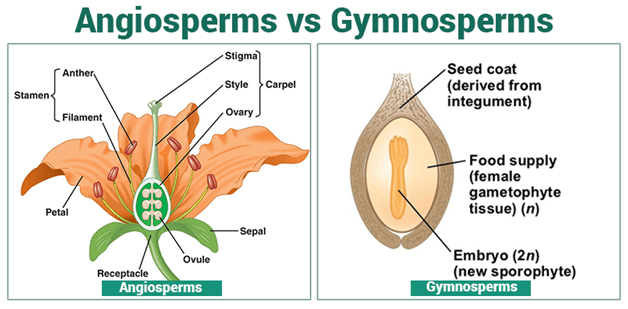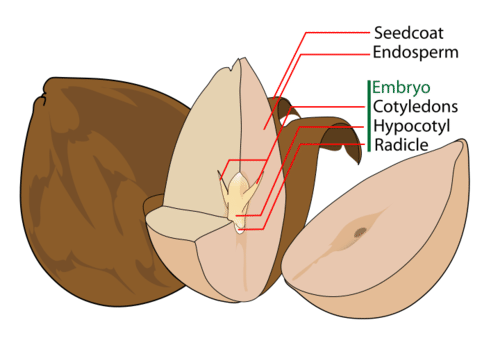Seed Plants Study Guide
Introduction
Spermatophytes are seed-producing plants. It was a huge event when vascular plants evolved to produce seeds, and it was possibly just as significant as the emergence of vascular tissues in plants!
Gymnosperms (seeds in cones) and angiosperms (seeds in capsules) are the two main categories of seed plants (seeds in ovaries of flowers). The ovary surrounds the angiosperm seed.
Seeds addressed the issue of producing progeny in a dry environment. Vascular seed plants and their descendants diversified after seeds developed, filling terrestrial niches worldwide. Vascular seed plants now predominate throughout the planet.
Evolution
- The first plants to colonize land are considered to have originated some 500 million years ago and were most likely closely linked to modern-day mosses (bryophytes).
- They were followed by liverworts (also bryophytes) and early vascular plants (pteridophytes), the ancestors of contemporary ferns.
- Bryophytes and pteridophytes, like gymnosperms and angiosperms, have a life cycle characterized by the alternation of generations; however, what distinguishes bryophytes and pteridophytes from gymnosperms and angiosperms is their reproductive necessity for water.
- The evolutionary tendency in seed plants resulted in a dominating sporophyte generation and, at the same time, a systematic reduction in the size of the gametophyte: from a large, visible structure to a microscopic cluster of cells encased in the sporophyte’s tissues.
- Seeds and pollen distinguish seed plants from other (seedless) vascular plants since they are both important adaptations to dryness and non-water reproduction. Both changes were necessary for the bryophytes and their descendants to colonize the land. According to fossils, the oldest distinguishable seed plants were around 350 million years ago. Gymnosperms are thought to have appeared around 319 million years ago, during the Pennsylvanian epoch.
- Angiosperms superseded gymnosperms in the late Mesozoic epoch around the middle of the Cretaceous (approximately 100 million years ago) and are now the most prevalent plant group in most terrestrial biomes.
Seed
- The embryo, seed coat, and stored nourishment are the three main components of a seed.
- A fertilized egg grows into an embryo. The embryo creates its first leaf (cotyledon) and begins to grow a stem (hypocotyl) and root while still inside the seed (radicle).
- The embryo is protected by the strong seed coat, which prevents it from drying out until germination circumstances are appropriate.
- The endosperm is the food stored in a seed, and it feeds the embryo until it can produce food on its own.
Gymnosperms
- Gymnosperms, which means “bare seeds,” are a paraphyletic group of seed plants. Not every member of a paraphyletic group is a descendant of a single common ancestor.
- Naked seeds, distinct female and male gametes, wind pollination, and tracheid are some of their features (which transport water and solutes in the vascular system).
- Gymnosperm seeds do not have an ovary and are instead exposed to cones or modified leaves.
- A gymnosperm’s life cycle includes alternating generations, with a dominating sporophyte that houses the female gametophyte and decreased gametophytes.
- Gymnosperms are all heterosporous plants. Cones or strobili are the male and female reproductive organs.
- Monoecious (“one house” or bisexual) plants produce male and female sporangia on the same plant, whereas dioecious (“two homes” or unisexual) plants generate male and female sporangia on different plants.

Angiosperms
- Flowers and fruit, two unique reproductive systems, are responsible for angiosperms’ success.
- The flower’s purpose is to ensure pollination. Flowers also shield the developing embryo and ovule inside the receptacle.
- The fruit’s purpose is to disperse seeds and safeguard the growing seed.
- Flowers are sporophylls, which are modified leaves arranged around a central stem. Flowers have the same structures, despite their differences in appearance: sepals, petals, carpels, and stamens. The peduncle is the stalk that connects the flower to the plant.
- The ovary’s walls thicken as the seed matures, forming the fruit. The seed develops in an ovary, which grows in size as the seeds mature. Fruit is a fertilized, fully formed, ripened ovary in botany.
- When a pollen grain reaches the stigma, a pollen tube emerges from the grain, grows down the style, and enters the ovule through the micropyle, which is an opening in the integuments. In the embryo sac, the two sperm cells are placed.
- After that, there is a double fertilization event. A diploid zygote—the future embryo—is formed when one sperm and one egg unite.
- The other sperm combines with the 2n polar nuclei to generate a triploid cell that will grow into endosperm, a food reserve tissue.
- The zygote matures into an embryo with a radicle, or tiny root, and one (monocot) or two (dicot) cotyledons, which are leaf-like structures.
- According to the anatomy of the cotyledons, pollen grains, and other components, flowering plants are separated into two primary groupings, monocots and dicots.
Hardy-Weinberg Equilibrium
Hardy-Weinberg Equilibrium states that –
A population’s genotype frequencies and allele frequencies will remain the same when there are no evolutionary mechanisms. In terms of plant breeding, the Hardy-Weinberg equilibrium says random-mating population which is not forced by the evolutionary processes of migration, selection, or mutation,both the genotype and allele frequencies remain constant forever.
The Hardy-Weinberg equilibrium does not occur in nature. This is because there is at least 1 rule that is violated. The Hardy-Weinberg equilibrium is a perfect state that gives a baseline for the scientists to measure gene revolution.
There are 2 equations to solve a Hardy-Weinberg Equilibrium question:
𝑝𝑝 + 𝑞𝑞 = 1__𝑝𝑝² + 2𝑝𝑝𝑞𝑞 + 𝑞𝑞² = 1 __
Frequency of –
𝑝𝑝 – Dominant allele𝑝𝑝² – Homozygous dominant genotype𝑞𝑞 – Recessive allele𝑞𝑞² – Homozygous recessive genotype2𝑝𝑝𝑞𝑞 – Heterozygous genotype
Conclusion
- The majority of vascular plants are seed plants, often known as spermatophytes. Seeds and pollen are used to replicate.
- Gymnosperms (seeds in cones) and angiosperms (seeds in capsules) are the two main categories of seed plants (seeds in ovaries of flowers).
- Gymnosperms develop seeds in cones.
- The embryo is protected by the strong seed coat, which prevents it from drying out until germination circumstances are appropriate.
FAQs:
1. What are seed plants?
A group of plants is known as seed plants. The category comprises gymnosperms and angiosperms, and Spermatophytes and phanerogams are other names for them. Seed plants dominate almost all terrestrial habitats.
2. What are the 2 types of seed plants?
Gymnosperms and angiosperms are 2 basic types of seed plants.
3. What is a seed in agriculture?
A basic ingredient in agriculture is the seed. A seed is, strictly speaking, an embryo, a live creature implanted in the supporting or food-storage tissue. The value of biological existence is given to seed, but the importance of sustaining tissue and economic production is given to grain.
4. Give some examples of seeds.
Wheat, rice, maize, sorghum, barley, peanut, soybean, lentil, and common pea seeds are examples of seeds.
5. Why are seed plants important?
Seed plants are grown for their aesthetics and aromas and their role in the creation of medications. Plants are also an important part of many people’s diets worldwide. Many cultures consume nearly entirely vegetarian food and rely only on seed plants to meet their nutritional requirements.
6. How are seeds produced?
Plants produce flowers to generate seeds. A flower must be pollinated to produce seed. Pollen from one flower’s male portion goes to another flower’s female section, where seeds are produced. The male and female components of most plants, but not all, are contained within a single bloom.
We hope you enjoyed studying this lesson and learned something cool about Seed Plants! Join our Discord community to get any questions you may have answered and to engage with other students just like you! Don’t forget to download our App to experience our fun, VR classrooms – we promise, it makes studying much more fun! 😎
]]>
